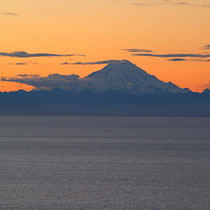
 |
|
|
January 29, 2009
Alaska's Redoubt Volcano may blow any minuteAlaska's Redoubt Volcano, 100 miles southwest of Anchorage, is expected to erupt within days or weeks, authorities at the Alaska Volcano Observatory say. 
"The level of seismic activity" has "increased markedly" in recent days at Mount Redoubt, according to the Observatory. From the Alaska Volcano Observatory: Summary of Current UnrestSince last fall, the Alaska Volcano Observatory (AVO) has detected increasing volcanic unrest at Redoubt Volcano. Starting on Friday, January 23, the level of seismic activity increased markedly, and on Sunday AVO raised the Aviation Color Code to ORANGE and the Volcano Alert Level to WATCH. On the basis of all available monitoring data AVO regards that an eruption similar to or smaller than the one that occurred in 1989-90 is the most probable outcome. We expect such an eruption to occur within days to weeks. In response to the current increase in activity, AVO has deployed a web camera approximately 7.5 miles north-northwest of the summit and will install additional seismic equipment at the volcano as weather permits. A second web camera also is pointed at Redoubt from a platform within Cook Inlet. The observatory in Anchorage is currently staffed 24 hours a day. We plan continued visual surveillance of the volcano's summit region, frequent airborne measurements of gas output, and frequent analysis of satellite and weather-radar data. Observations and BackgroundBeginning in September 2008, AVO received reports of a strong hydrogen sulfide (H2S) odor downwind of Redoubt. During an observation flight on September 26, a melt hole was observed in the upper Drift glacier, down slope from the location of historical eruptive vents. Gas-measurements flights in October and November detected elevated levels of sulfur dioxide (SO2), carbon dioxide (CO2), and H2S. Through the fall, melt holes increased in size, and several points of steaming and gas emissions were observed in the area of the lava domes extruded during the 1989-90 and 1966-68 eruptions. Concurrent with visual observations and gas data, a subtle increase in seismic activity was also detected beneath the volcano. Seismicity took the form of episodic, very weak volcanic tremor, consistent with the movement of fluids and gases within the volcano. AVO also located deep (30 km, or 19 miles, below sea level) long-period earthquakes, which were few in number but possibly indicative of magma recharge deep within Redoubt's plumbing system. Beginning on the evening of Friday, January 23, 2009, seismic activity increased at stations closest to Redoubt's summit. The seismicity consists of a combination of discrete, relatively small earthquakes and periods of more continuous volcanic tremor. This activity intensified early Sunday morning, January 25, at which time AVO raised the Aviation Color Code to ORANGE and the Volcano Alert Level to WATCH. Since Sunday, seismicity has waxed and waned but has remained well above background levels. The seismic unrest observed over the past few days is unusual for Redoubt and has not been seen since just prior to the 1989-90 eruption. Overflights on January 26 and 27 documented continued production of water vapor and volcanic gas plumes from the summit crater; increased melting has produced small flows of debris at the north base of the volcano. The most recent eruptions of Redoubt, in 1966-68 and 1989-90, were characterized by large explosions that produced ash clouds reaching as high as 40,000 ft asl. During the 1989-90 eruption, the largest ash fall from a single event in Kenai was 5 millimeters (0.2 inches), but ash fall was widespread and noted as far away as Fairbanks, along the Richardson Highway, and the Yukon Territory border. Other ash-producing events during the 1989-90 eruption deposited several millimeters of ash on the Kenai Peninsula and trace amounts of ash in Anchorage and more distant locations over several months. The 1989-90 eruption also several disrupted air traffic operations in and out of Anchorage. Other hazards from past and likely future eruptions include hot pyroclastic flows that may travel several miles from the volcano, especially to the north, and volcanic mudflows, or lahars, that travel many miles from their source. Lahars form as hot pyroclastic flows, often caused by collapse of a growing lava dome, swiftly melt large volumes of snow and ice downslope of the summit crater. In 1989-90, lahars flowed east down the Drift River, at least three of which reached Cook Inlet and one of which partially flooded the Drift River Oil Terminal facility. Lahars produced by eruptions of Redoubt Volcano may range from dense, gravel-rich flows to watery, sediment-laden floods. All such flows can transport boulder-size particles, and water within these flows temporarily may be at boiling temperatures. It could take a typical lahar 1-2 hours to travel from the base of the volcano to the mouth of the Drift River. © AlaskaReport.com All Rights Reserved. |
|